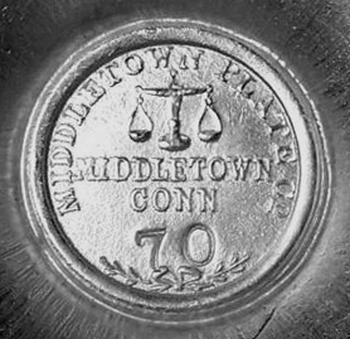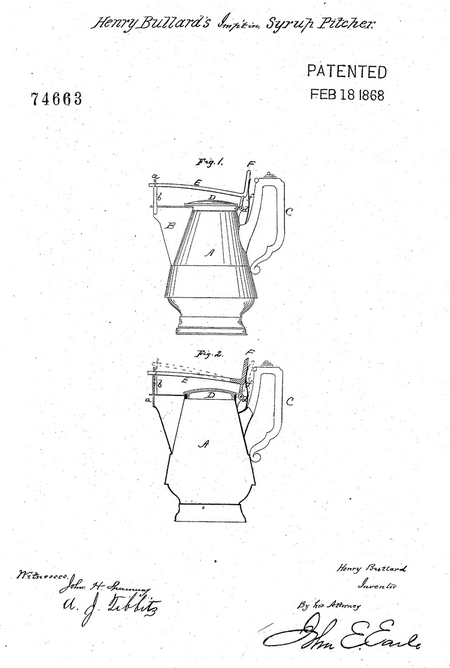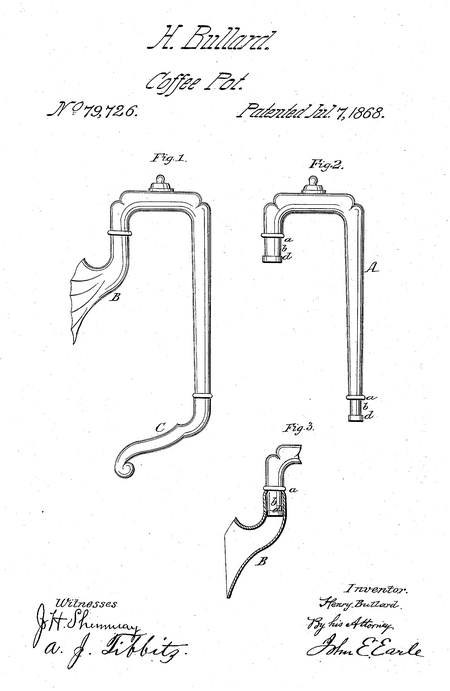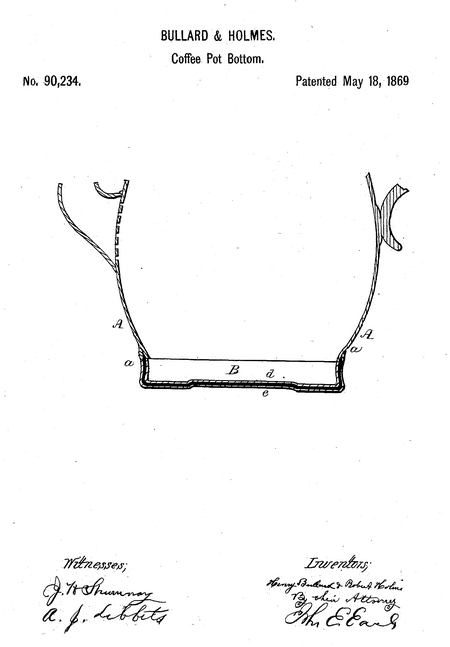Henry Bullard
- Born: 21 Jun 1833, Middletown CT
- Died: 25 Oct 1910
General notes:
Pewtersmith and silverplater
Events in his life were:
- He worked circa 1855-1863 as a silverplater in Baltimore MD probably in the shop of William Holmes.


- Patent: 74,663, on 18 Feb 1868. HENRY BULLARD, OF MIDDLETOWN, CONNECTICUT.
Letters Patent No. 74,663, dated February 18, 1868.
IMPROVED SIRUP-PITCHER
TO ALL WHOM IT MAY CONCERN:
Be it known that I, Henry Bullard, of Middletown, in the county of Middlesex, and State of Connecticut, have invented a new Improvement in Sirup-Pitchers; and I do hereby declare the following, when taken in connection with the accompanying drawings, and the letters of reference marked thereon, to be a full, clear, and exact description, of the same, and which said drawings constitute part of this specification, and represent, inó
Figure 1, a side view, and in
Figure 2 a vertical central section.
This invention relates particularly to an improvement in that class of pitchers employed for pouring sirup, but is alike applicable to pitchers for similar purposes, the object being to construct a cut-off to prevent the drip from the spout of the pitcher. Various devices have been produced to accomplish this object, but none have fully accomplished the desired result. My invention, by which I do obtain the desired result, consists in the arrangement of a slide at the outer extremity of the spout, operated so as to positively cut off and prevent the drip.
In order to the clear understanding of my improvement, as well as to enable others to construct the same, I will proceed to a description thereof as illustrated in the accompanying drawings.
A is the pitcher, B the spout, C, the handle, and D the cover, of common construction. Upon the outer or discharge-end of the spout, I arrange a slide, a, in proper guides, i, so that the said slide will move freely up and down, across, and so as to close the opening of the spout. The best means which I have yet devised for operating the said slide is by a lever, E, pivoted at d, and carried back to within such-relative position to the handle C that the thumb of the hand grasping the handle may be.extended and placed upon the end, F, of the said lever, so as to raise the lever to the position denoted in blue, fig. 2, thus raising the slide and opening the spout, and when released from the depression of the thumb, a spring, f, or its equivalent, forces the slide down and perfectly closes the opening of the spout. The operation of the slide, thus arranged, will be readily understood by reference to the drawings.
In the drawing I have shown the slide as operating vertically to close the spout. The position of the slide must, of course, be adapted to the peculiar form of the spout, and such adaptation those skilled in this class of manufactures will, readily perceive.
Having thus fully described my invention, what I claim as new and useful, and desire to secure by Letters Patent, isó
The arrangement of the slide or cut-off a upon the spout B, independent of the cover, and in combination with a lever and spring, as a means of operating the said slide, substantially as herein set forth.
Henry Bullard
Witnesses
Elmore Penfield
G. H. Hulburt

- Patent: 79,726, on 7 Jul 1868. HENRY BULLARD, OF MIDDLETOWN, CONNECTICUT.
Letters Patent No. 79,726, dated July 7, 1868.
IMPROVEMENT IN HANDLES FOR TEA AND COFFEE-POTS.
TO ALL WHOM IT MAY CONCERN:
Be it known that I, Henry Bullard, of Middletown, in the county of Middlesex, and State of Connecticut, have invented a new Improvement in Handles for Tea and Coffee-Pots; and I do hereby declare the following, when taken in connection with the accompanying drawings, and the letters of reference marked thereon, to be a full, clear, and exact description of the same, and which said drawings' constitute part of this specification, and represent, inó
Figure 1, a side view, with the tips detached.
Figure 2, the same, detached from the tips, and in
Figure 3, a vertical section, showing the manner of attachment.
This invention relates to an improvement in the construction of handles for tea and coffee-pots, and consists in forming the handle proper from hard rubber, or similar plastic material, and so that the tips may be attached thereto, without the intervention of other material than the tips and handle proper.
In order to the clear understanding ofimy improvement, I will fully describe the same as illustrated in the accompanying drawings.
A is the handle, as seen in fig. 2, and may be of any desirable form and configuration of design, formed from hard rubber, or similar plastic material, by making a mould corresponding to the form desired, and compressing the material into the said mould, in the usual manner of forming articles from hard rubber, and cured or hardened by a process applicable to the material used.
The ends, to which the metallic tips B and C are to be attached, I form so as to leave a shoulder, a, above a recess or reduced diameter, b, below which is formed another shoulder, d, as seen in fig. 2, and construct the tips to correspond to their respective ends, so as to set on the, lower and against the upper shoulder, as seen in fig. 3, and when so set, the notch of the tip is compressed into thereduced portion, so as to secure the tip to the handle, the tips themselves being secured to the tea or coffee-pot in the usual manner.
The handle thus constructed may be of any desirable color, and being a non-conductor of heat, is peculiarly adapted for this purpose, is exceedingly strong, and much cheaper than the metallic handle heretofore used. Having thus fully described my invention, what I claim as new and useful, and desire to secure by Letters Patent, isó
Handles for tea and coffee-pots, formed from hard rubber or similar material, and so as to be attached to the tips B and C, substantially in the manner herein set forth, as a new article of manufacture.
Henry Bullard
Witnesses:
Elmore Penfield
Edward Payne

- Patent: 90,234, on 18 May 1869. HENRY BULLARD AND ROBERT HOLMES, OF MIDDLETOWN, CONNECTICUT.
Letters Patent No. 90,234, dated May 18, 1869.
IMPROVEMENT IN HARD-METAL BOTTOMS FOR TEA AND COFFEE-POTS.
To all whom it may concern:
Be it known tbat we, Henry Bullard and Robert Holmes, of Middletown, in the county of Middlesex, and State of Connecticut, have invented a new Improvement in Tea and Coffee-Pots; and we do hereby declare the following, when taken in connection with the accompanying drawings, and the letters of reference marked thereon, to be a full, clear, and exact description of the same, and which said drawings constitute part of this specification, and represent a vertical central section of the lower portion of a tea or coffee-pot.
This invention relates to an improvement in Britannia tea and coffee-pots, especially in that class which is constructed with what are termed fire-proof bottoms, that is, bottoms of a harder metal than Britannia, and capable of sustaining a greater degree of heat, iron, tinned, being the metal commonly used.
While the fire-proof bottom overcomes the liability to injure it by heat, another difficulty arises, which makes it a serious objection to this class of pots, that, is, to its liability to rust.
To overcome this objection is the object of our invention, which consists in coating a hard-metal or iron bottom, both inside and out, with porcelain, the iron bottom being soldered to the Britannia top in the usual manner.
To enable others to construct our improvement, we
will proceed to describe the same as illustrated in the accompanying drawings.
A is the top or body of the pot, formed from Britannia or similar metal.
B, the bottom, struck into shape, so as to be attached to the body by solder, as at a. It is formed from hard metal, such as iron, and coated, both inside and out, with porcelain, as deuoted at d and e, covering up all exposed portions of the iron.
The coating is done before the attachment of the bottom and body together, inasmuch as the Britannia would not stand the degree of heat required in baking the porcelain.
By this construction, all liability to rust is avoided, as the contents of the pot can in no way come in contact with the metal, and the outside is also protected from dampness, or other causes which might occasion rust.
Having, therefore, thus fully described our invention.
What we claim as new and useful, and desire to secure by Letters Patent, isó
In a tea or coffee-pot constructed with a hard-metal bottom, coating the said hard-metal bottom with porcelain, in the manner and for the purpose set forth.
Henry Bullard
Robert Holmes
Witnesses:
Elmore Penfield
John G. Pelten
- He appeared on the census in 1870 in Middletown CT. Listed as a britannia manufacturer.
- He appeared on the census in 1880 in Middletown CT. Listed as a silverplate manufacturer.
|







